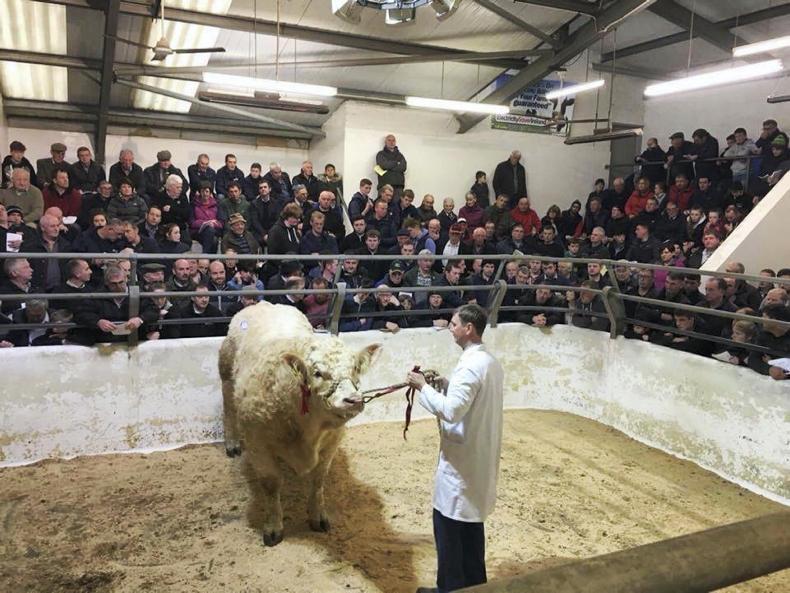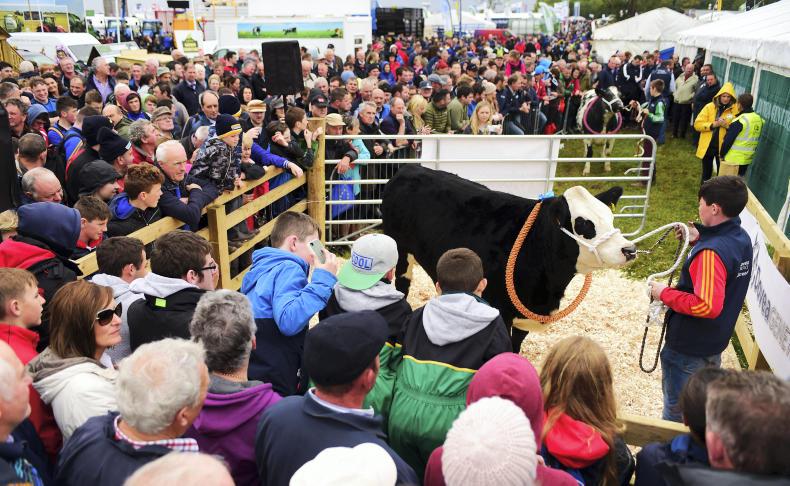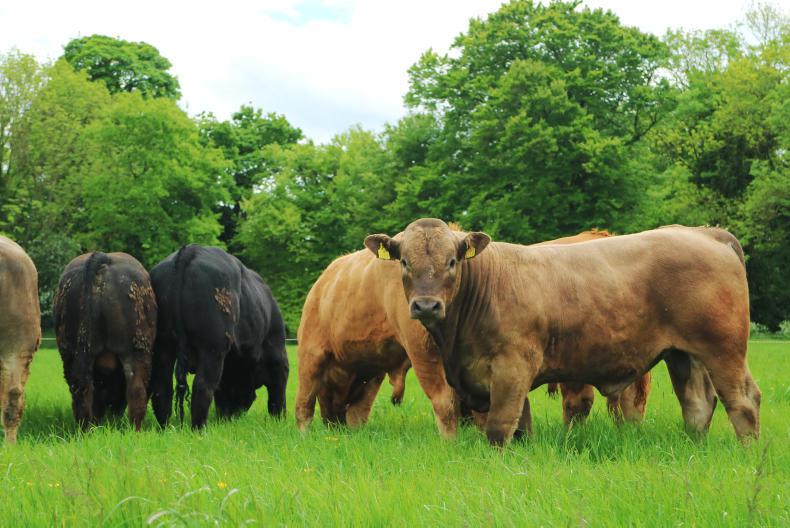The ICBF publishes its index values in euro for all beef animals in Ireland.
These index values are the end result of a genetic evaluation run.
A genetic evaluation run identifies all of the progeny and relatives of a bull and compares their performance records to those of their herdmates.
It also includes an animal’s genotype, if it is available. It then applies the economic values to this data, as some traits are more valuable than others.
For instance, “milk” is a more valuable trait than “coat colour”.
We have two main beef indices here – replacement and terminal.
These indices have grouped traits together depending on their importance for achieving an overall goal.
The replacement index estimates how suitable a bull’s daughters will be for calving ability, milk and fertility and ultimately being good low-maintenance suckler cows.
The traits that a suckler cow will need to be good at are basically grouped together.
They each then carry a different weighting in the index depending on how economically important they are.
The terminal index estimates how profitable a bull’s progeny will be for liveweight, carcase conformation and ultimately being finished for slaughter themselves.
The actual €uro-Stars just make the €uro index values visually easy to understand.
The €uro-Stars show where the animal’s genetic index ranks (top 20%, bottom 20% etc).
The lists
The active beef bull lists show the highest-ranked beef AI sires on the replacement and terminal indices that have semen widely available, based on the August 2017 genetic evaluations computed by ICBF.
The criteria for making the list are as follows:
Bull is genotyped.Reliability percentage for replacement or terminal index and calving difficulty of at least 50%.Bull must also have calves in his calving survey evaluation.Have a plan
It is critically important to have a plan for what you intend doing with the progeny of the bull or bulls you pick. Yes, a bull could be five-star, but for what?
The terminal index list is for selecting bulls with a view to finishing or selling all of their progeny.
This index is heavily loaded towards calving ease and obviously the terminal carcase traits.
The replacement index list is for selecting bulls that you will be retaining some daughters of for breeding. This index has a mix of 60% maternal traits and 40% terminal traits.

A breakdown of the breed and AI Company spread across the top 35 lists for both indices are shown in Table 1 and Table 2.
There are eight breeds represented on the replacement index list and six breeds represented on the terminal index list. Five AI companies are marketing their semen, with the price per straw ranging from €10 to €50 and the vast majority selling for €10/ straw to €12/straw.
More €uro-Star details on these and all of the other available AI bulls is available at www.icbf.com

Understand the terminology
1 Bull details:
Rank, AI code, name, breed.
2 Genotyped:
This column confirms that the AI sire has his own genomic data included in his Index.
3 Replacement or terminal index:
This is the overall single figure profit index that each bull has.
A bull with a replacement index of €200 is expected to sire daughters that are €200 more profitable than the average Irish suckler cow. Likewise, the terminal index is an indication of how profitable a bull’s progeny will be when slaughtered.
4 Reliability %:
This figure is an indication as to how confident ICBF can be about the genetic evaluations for a particular bull.
Progeny of a bull having data recorded on them (calving survey, weights etc) alongside lots of other animals, across large numbers of herds is what increases a bull’s reliability percentage figure.
The reliability percentage figures for AI sires is generally higher than that of stock bulls due to the large number of calves across many herds that they would sire.
5 Stars across:
This shows the percentile ranking of the bulls index when compared across breed (5 stars: top 20%, 1 star: bottom 20%).
6 Calv diff % and rel%: Calving difficulty % is the expected percentage of difficult calvings that a bull will bring. The reliability % of that figure is also shown.
7 No. of records:
This gives the actual number of calving survey records for each bull.
8 Docility:
This gives an indication as to how quiet the progeny of the bull will be. Higher stars = more docile. The higher the reliability, the more of a bull’s progeny that would have had docility recorded on them.
9 Daughter milk:
Daughter milk is the expected level of milk that daughters of a bull will have. It is expressed in terms of the kg weight gain from the progeny of those daughters (high values desired).
10 Daughter calving interval:
Daughter calving interval is a key measurement of fertility in a bull’s daughters (negative and low values desired).
11 Carcase weight and carcase conformation:
This shows the extra kg of carcase and increased conformation that is expected from progeny of each bull.
12 Semen details:
price and supplier details of each bull are included.
Read more
Five steps to improving heat detection
Key tips for DIY winter AI users
The full winter AI focus
The ICBF publishes its index values in euro for all beef animals in Ireland.
These index values are the end result of a genetic evaluation run.
A genetic evaluation run identifies all of the progeny and relatives of a bull and compares their performance records to those of their herdmates.
It also includes an animal’s genotype, if it is available. It then applies the economic values to this data, as some traits are more valuable than others.
For instance, “milk” is a more valuable trait than “coat colour”.
We have two main beef indices here – replacement and terminal.
These indices have grouped traits together depending on their importance for achieving an overall goal.
The replacement index estimates how suitable a bull’s daughters will be for calving ability, milk and fertility and ultimately being good low-maintenance suckler cows.
The traits that a suckler cow will need to be good at are basically grouped together.
They each then carry a different weighting in the index depending on how economically important they are.
The terminal index estimates how profitable a bull’s progeny will be for liveweight, carcase conformation and ultimately being finished for slaughter themselves.
The actual €uro-Stars just make the €uro index values visually easy to understand.
The €uro-Stars show where the animal’s genetic index ranks (top 20%, bottom 20% etc).
The lists
The active beef bull lists show the highest-ranked beef AI sires on the replacement and terminal indices that have semen widely available, based on the August 2017 genetic evaluations computed by ICBF.
The criteria for making the list are as follows:
Bull is genotyped.Reliability percentage for replacement or terminal index and calving difficulty of at least 50%.Bull must also have calves in his calving survey evaluation.Have a plan
It is critically important to have a plan for what you intend doing with the progeny of the bull or bulls you pick. Yes, a bull could be five-star, but for what?
The terminal index list is for selecting bulls with a view to finishing or selling all of their progeny.
This index is heavily loaded towards calving ease and obviously the terminal carcase traits.
The replacement index list is for selecting bulls that you will be retaining some daughters of for breeding. This index has a mix of 60% maternal traits and 40% terminal traits.

A breakdown of the breed and AI Company spread across the top 35 lists for both indices are shown in Table 1 and Table 2.
There are eight breeds represented on the replacement index list and six breeds represented on the terminal index list. Five AI companies are marketing their semen, with the price per straw ranging from €10 to €50 and the vast majority selling for €10/ straw to €12/straw.
More €uro-Star details on these and all of the other available AI bulls is available at www.icbf.com

Understand the terminology
1 Bull details:
Rank, AI code, name, breed.
2 Genotyped:
This column confirms that the AI sire has his own genomic data included in his Index.
3 Replacement or terminal index:
This is the overall single figure profit index that each bull has.
A bull with a replacement index of €200 is expected to sire daughters that are €200 more profitable than the average Irish suckler cow. Likewise, the terminal index is an indication of how profitable a bull’s progeny will be when slaughtered.
4 Reliability %:
This figure is an indication as to how confident ICBF can be about the genetic evaluations for a particular bull.
Progeny of a bull having data recorded on them (calving survey, weights etc) alongside lots of other animals, across large numbers of herds is what increases a bull’s reliability percentage figure.
The reliability percentage figures for AI sires is generally higher than that of stock bulls due to the large number of calves across many herds that they would sire.
5 Stars across:
This shows the percentile ranking of the bulls index when compared across breed (5 stars: top 20%, 1 star: bottom 20%).
6 Calv diff % and rel%: Calving difficulty % is the expected percentage of difficult calvings that a bull will bring. The reliability % of that figure is also shown.
7 No. of records:
This gives the actual number of calving survey records for each bull.
8 Docility:
This gives an indication as to how quiet the progeny of the bull will be. Higher stars = more docile. The higher the reliability, the more of a bull’s progeny that would have had docility recorded on them.
9 Daughter milk:
Daughter milk is the expected level of milk that daughters of a bull will have. It is expressed in terms of the kg weight gain from the progeny of those daughters (high values desired).
10 Daughter calving interval:
Daughter calving interval is a key measurement of fertility in a bull’s daughters (negative and low values desired).
11 Carcase weight and carcase conformation:
This shows the extra kg of carcase and increased conformation that is expected from progeny of each bull.
12 Semen details:
price and supplier details of each bull are included.
Read more
Five steps to improving heat detection
Key tips for DIY winter AI users
The full winter AI focus














SHARING OPTIONS